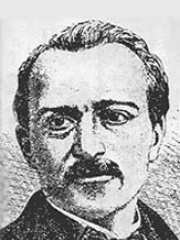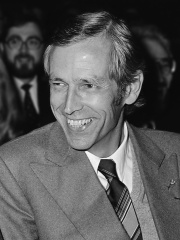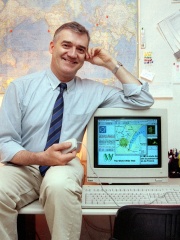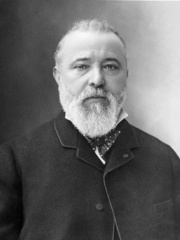





The Most Famous
INVENTORS from Belgium
Top 7
The following people are considered by Pantheon to be the most legendary Belgian Inventors of all time. This list of famous Belgian Inventors is sorted by HPI (Historical Popularity Index), a metric that aggregates information on a biography's online popularity.

1. Adolphe Sax (1814 - 1894)
With an HPI of 73.75, Adolphe Sax is the most famous Belgian Inventor. His biography has been translated into 63 different languages on wikipedia.
Antoine-Joseph "Adolphe" Sax (French: [ɑ̃twan ʒozɛf adɔlf saks]; 6 November 1814 – 7 February 1894) was a Belgian inventor and musician who invented the saxophone in the early 1840s, patenting it in 1846. He also invented the saxotromba, saxhorn and saxtuba, and redesigned the bass clarinet in a fashion still used in the 21st century. He played the flute and clarinet.

2. Étienne Lenoir (1822 - 1900)
With an HPI of 71.18, Étienne Lenoir is the 2nd most famous Belgian Inventor. His biography has been translated into 38 different languages.
Jean Joseph Étienne Lenoir, also known as Jean J. Lenoir (12 January 1822 – 4 August 1900), was a Belgian-French engineer who invented the internal combustion engine in 1858. Prior designs for such engines were patented as early as 1807 (De Rivaz engine) and 1854 (Barsanti–Matteucci engine). He was born in Mussy-la-Ville (then in Luxembourg, part of the Belgian Province of Luxembourg since 1839). In 1838, he immigrated to France, taking up residence in Paris, where he developed an interest in electroplating. His interest in the subject led him to make several electrical inventions, including an improved electric telegraph.

3. Jacques Piccard (1922 - 2008)
With an HPI of 69.96, Jacques Piccard is the 3rd most famous Belgian Inventor. His biography has been translated into 38 different languages.
Jacques Piccard (28 July 1922 – 1 November 2008) was a Swiss oceanographer and engineer, known for having developed submarines for studying ocean currents. In the Challenger Deep, he and Lieutenant Don Walsh of the United States Navy were the first people to explore the deepest known part of the world's ocean, and the deepest known location on the surface of Earth's crust, the Mariana Trench, located in the western North Pacific Ocean.

4. Paul Otlet (1868 - 1944)
With an HPI of 66.22, Paul Otlet is the 4th most famous Belgian Inventor. His biography has been translated into 27 different languages.
Paul Marie Ghislain Otlet (; French: [pɔl maʁi ɡilɛ̃ ɔtlɛ]; 23 August 1868 – 10 December 1944) was a Belgian author, lawyer and peace activist; who was a foundational figure in documentalism, a precursory discipline to information science. Otlet created the Universal Decimal Classification, which would later become a faceted classification. Otlet was responsible for the development of an early information retrieval tool, the "Repertoire Bibliographique Universel" (RBU). RBU was used by the International Institute of Bibliography which later became the Mundaneum. Otlet wrote numerous essays on how to collect and organize and connect knowledge, culminating in two books, the Traité de Documentation (1934) and Monde: Essai d'universalisme (1935). His ideas for information collection, storage and retrieval have been compared to early incarnations of the internet and search engines. In 1907, following a huge international conference, Otlet and Henri La Fontaine created the Central Office of International Associations, which was renamed to the Union of International Associations in 1910, and which is still located in Brussels. They also created a great international center called at first Palais Mondial (World Palace), later, the Mundaneum to house the collections and activities of their various organizations and institutes. Otlet witnessed an unprecedented proliferation of information, resulting in the creation of new kinds of international organization. Otlet also endorsed the internationalist politics of the League of Nations and its International Institute of Intellectual Cooperation (the forerunner of UNESCO) along with fellow Mundaneum founder La Fontaine.

5. Zénobe Gramme (1826 - 1901)
With an HPI of 65.54, Zénobe Gramme is the 5th most famous Belgian Inventor. His biography has been translated into 27 different languages.
Zénobe Théophile Gramme (French pronunciation: [zenɔb teɔfil ɡʁam]; 4 April 1826 – 20 January 1901) was a Belgian electrical engineer. He was born at Jehay-Bodegnée on 4 April 1826, the sixth child of Mathieu-Joseph Gramme, and died at Bois-Colombes on 20 January 1901. He invented the Gramme machine, a type of direct current dynamo capable of generating smoother (less AC) and much higher voltages than the dynamos known to that point.

6. Robert Cailliau (b. 1947)
With an HPI of 64.78, Robert Cailliau is the 6th most famous Belgian Inventor. His biography has been translated into 29 different languages.
Robert Cailliau (last name pronunciation: [kajo], born 26 January 1947) is a Belgian informatics engineer who proposed the first (pre-www) hypertext system for CERN in 1987 and collaborated with Tim Berners-Lee on the World Wide Web (jointly winning the ACM Software System Award) from before it got its name. He designed the historical logo of the WWW, organized the first International World Wide Web Conference at CERN in 1994 and helped transfer Web development from CERN to the global Web consortium in 1995. He is listed as co-author of How the Web Was Born by James Gillies, the first book-length account of the origins of the World Wide Web.

7. George Washington (1871 - 1946)
With an HPI of 60.55, George Washington is the 7th most famous Belgian Inventor. His biography has been translated into 19 different languages.
George Constant Louis Washington[I] (May 20, 1871 – March 29, 1946) was a Belgian-British inventor and businessman. He is best remembered for his improvement of an early instant coffee process and for the company he founded to mass-produce it, the G. Washington Coffee Company. An emigrant from his native Belgium, he arrived in the New York area in 1897. He dabbled in several technical fields before hitting upon manufacturing an adapted version of the nascent instant coffee, during a sojourn in Central America in 1906 or 1907. He began selling his coffee in 1909 and founded a company to manufacture it in 1910. Based in New York and New Jersey, his company prospered and became an important military supplier during World War I. The company's products were also advertised in New York newspapers and on the radio. The success of his company made Washington wealthy, and he lived in a mansion in Brooklyn and then moved to a country estate in New Jersey in 1927. In that same year, he lost a dispute with the tax authorities. Washington was married and had three children. Washington's company was sold to American Home Products in 1943, shortly before his death. Though the coffee brand was discontinued by 1961, Washington's name is still used today in the product G. Washington's Seasoning & Broth.
People
Pantheon has 7 people classified as Belgian inventors born between 1814 and 1947. Of these 7, 1 (14.29%) of them are still alive today. The most famous living Belgian inventors include Robert Cailliau. The most famous deceased Belgian inventors include Adolphe Sax, Étienne Lenoir, and Jacques Piccard.
Living Belgian Inventors
Go to all RankingsDeceased Belgian Inventors
Go to all RankingsAdolphe Sax
1814 - 1894
HPI: 73.75
Étienne Lenoir
1822 - 1900
HPI: 71.18
Jacques Piccard
1922 - 2008
HPI: 69.96
Paul Otlet
1868 - 1944
HPI: 66.22
Zénobe Gramme
1826 - 1901
HPI: 65.54
George Washington
1871 - 1946
HPI: 60.55
Overlapping Lives
Which Inventors were alive at the same time? This visualization shows the lifespans of the 6 most globally memorable Inventors since 1700.

